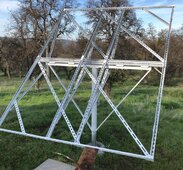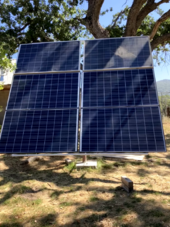pilot light
New Member
Greetings, photosynthesizers.
I am very interested in energy efficiency, but have no practical experience with solar panels and batteries. I live in a hurricane-prone area and was wondering about the feasibility of running a small window a/c unit post-hurricane with solar, when grid power is down. In general, I can camp in my own house with no power comfortably for a few days, with the exception of being unable to sleep when that post-storm heat, stillness, and humidity settles in.
Running a gas generator at night is a good way to make your neighbors hate you, and also get your generator stolen/damaged.
My question is, what would be the minimum necessary investment to keep a small room at a reasonable temperature and humidity-level with a window a/c unit and maybe the ability to charge a phone?
The a/c unit I was looking at was this: Frigidaire GHWQ083WC1
This claims to be as efficient as the U-shaped one you guys suggest, but seems easier to install. Note that this would not be a permanent installation in the window, just something I'd use in case of emergency.
Also, given that this would not be a full-time set-up (I don't actually have space for the panels full-time, but could certainly deal with them in this case), I am not so interested in picking up rolling my own generator package as a hobby. I am quite willing to take the boring way out and get an out-of-the-box solution. I was looking at the EcoFlow units, but I don't know if running the a/c unit on one of the smaller models is a complete fantasy or not.
I'm basically just trying to figure a ballpark cost and equipment solution. If the cost creeps up high enough, it probably makes more sense just to pack up and drive as far away as necessary to get a hotel until the situation calms down.
I'm open to any suggestions, including opinions as to why the a/c unit I'm looking at might not be the right one for the problem, and I'm not married to any particular brand of battery/panels.
Just working through this as a mental exercise makes me realize how crazy it is that humans even settled this part of the country without immediate access to electricity!
Thanks for your time.
I am very interested in energy efficiency, but have no practical experience with solar panels and batteries. I live in a hurricane-prone area and was wondering about the feasibility of running a small window a/c unit post-hurricane with solar, when grid power is down. In general, I can camp in my own house with no power comfortably for a few days, with the exception of being unable to sleep when that post-storm heat, stillness, and humidity settles in.
Running a gas generator at night is a good way to make your neighbors hate you, and also get your generator stolen/damaged.
My question is, what would be the minimum necessary investment to keep a small room at a reasonable temperature and humidity-level with a window a/c unit and maybe the ability to charge a phone?
The a/c unit I was looking at was this: Frigidaire GHWQ083WC1
This claims to be as efficient as the U-shaped one you guys suggest, but seems easier to install. Note that this would not be a permanent installation in the window, just something I'd use in case of emergency.
Also, given that this would not be a full-time set-up (I don't actually have space for the panels full-time, but could certainly deal with them in this case), I am not so interested in picking up rolling my own generator package as a hobby. I am quite willing to take the boring way out and get an out-of-the-box solution. I was looking at the EcoFlow units, but I don't know if running the a/c unit on one of the smaller models is a complete fantasy or not.
I'm basically just trying to figure a ballpark cost and equipment solution. If the cost creeps up high enough, it probably makes more sense just to pack up and drive as far away as necessary to get a hotel until the situation calms down.
I'm open to any suggestions, including opinions as to why the a/c unit I'm looking at might not be the right one for the problem, and I'm not married to any particular brand of battery/panels.
Just working through this as a mental exercise makes me realize how crazy it is that humans even settled this part of the country without immediate access to electricity!
Thanks for your time.





